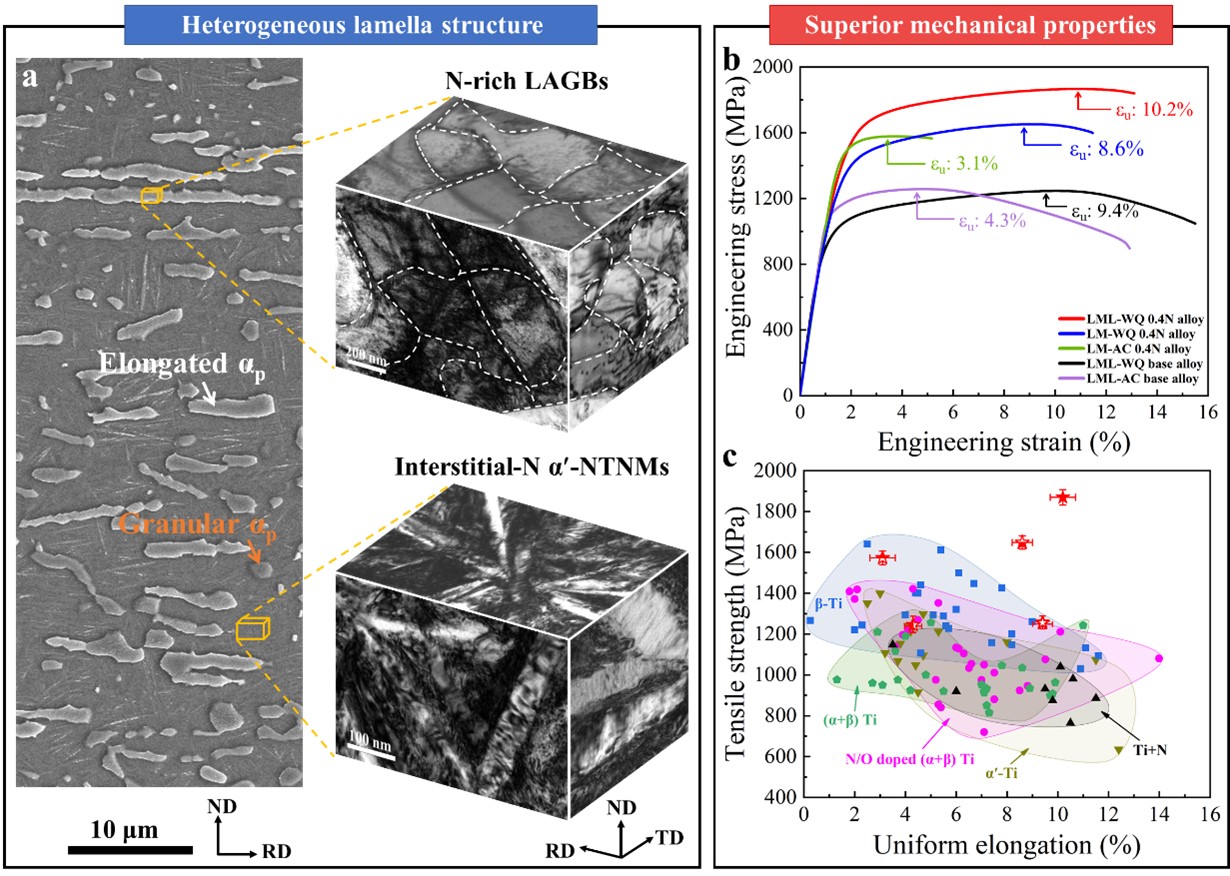As one of the most important high-specific-strength structural materials, duplex (α+β) Ti alloys exhibit a broad range of mechanical properties by tailoring their major constituent-HCP α phase. However, high-strength duplex Ti alloys often confront low work hardening rate (WHR, Θ) and thus the limited uniform elongation (εu), due to the following two factors. i) The HCP α-phase often lacks <c+a> dislocations due to the excessive critical resolved shear stress (CRSS), rendering intrinsically limited ductility. ii) The secondary α-precipitate/β-matrix semi-coherent phase boundaries (PBs) lead to strain incompatibility and thus stress concentrations for reduced ductility. More importantly, the strength-ductility trade-off in duplex Ti alloys caused by the above two reasons is further amplified by interstitial atom-poisoning effects. This is because the strong interstitial atom-dislocation interactions exacerbate the above two drawbacks, i.e., increasing the CRSS to suppress activation of <c+a> dislocations and strengthening the α-phase to intensify strain incompatibility at α/β PBs. So far, extensive efforts have been made in duplex Ti alloys to alleviate the interstitial embrittlement effect, such as in Ti-6Al-4V and Ti-Fe alloys doped with interstitial atoms (N and O). However, they still exhibit relatively limited yield strength (σy < 1300 MPa) and uniform elongation (εu < 7%). Among the commonly incorporated interstitial atoms in Ti alloys, despite N has the strongest interstitial hardening capacity, it has been underexplored in duplex Ti alloys due to embrittlement concerns. Therefore, how to utilize the exceptional strengthening capacity of interstitial N atoms with effective embrittlement mitigation remains a critical challenge in the development of high-performance Ti alloys.
In response to these challenges, the team led by Academician Sun Jun and Prof. Zhang Jinyu from the State Key Laboratory of Metallic Materials Strength at Xi'an Jiaotong University has demonstrated that the adverse role of interstitial N atoms can be turned around so that they can elevate the ductility of duplex Ti alloys. The underlying principle of this strategy lies in: the interstitial atom-dislocation interactions not only promote the formation of strong substructures of solute segregation (e.g., low-angle grain boundaries, LAGBs) for pronounced strengthening, but also tend to segregate the dislocation core to mediate phase transformation. Therefore, the team developed a simple cyclic hot-rolling and short-time-solution (HR&SS) processing to control N-dislocation interactions at high temperatures for tailoring microstructures (i.e., α and β phases) in Ti-2.8Cr-4.5Zr-5.2Al-0.4N (wt.%) alloys. Specifically, for the primary α (αp) phase, the N-dislocation interactions not only promote wavy slip to produce enough dislocations during hot-rolling, but also prevent dislocation annihilation during short-time solutioning, which facilitates forming N-rich LAGBs. For the high-temperature β-phase, this interaction distorts the planar stress fields of edge dislocations into the nonplanar stress fields, which promotes the formation of coherent and interstitial-N α′-nanotwinned martensites (α′-NTNMs) during water quenching (WQ). Based on this, obtain a heterogeneous lamella structure consisting of elongated αp grains decorated with N-rich LAGBs and βtrans structure with interstitial-N α′-NTNMs that elevate the flow stress to reach the CRSS for activating <c+a> dislocations, promoting N-rich LAGBs and α′-NTNM PBs as prolific dislocation sources, leading to wavy slip and the c-axis deformation, and interstitial-N α′-NTNMs coherent with the matrix to alleviate stress concentrations. This lamellar structure (Fig. 1a), designed by using bifunctional N-dislocation interactions, lends N-doped Ti-Cr-Zr-Al duplex Ti alloys excellent mechanical properties with ultra-high yield/tensile strength of ≈1532/1869 MPa and large uniform elongation of εu ≈10.2%, together with high work hardening capability as (σUTS - σ0.2) ≈337 MPa, surpassing all currently reported Ti alloys (Fig. 1b-c). The team has proposed a bifunctional interstitial atom-dislocation interaction to construct unique microstructures, enabling ultrahigh strength and large tensile plasticity in interstitial-strengthened Ti alloys, with promising potential for extension to other high-performance alloy materials.

Figure 1. (a) Heterogeneous lamella structure of the Ti-Cr-Zr-Al-0.4N (wt.%) alloy. (b) Tensile stress-strain curves of Ti-Cr-Zr-Al alloys with different microstructures and N-doped Ti-Cr-Zr-Al alloys. (c) Maps of σUTS vs εu of our base and N-doped Ti-Cr-Zr-Al alloys compared with those of previously reported, including β-Ti alloys, martensite α′ Ti alloys, (α+β) Ti alloys, O/N-doped (α+β) Ti alloys, and N-doped HCP-Ti.
This research was published online in Advanced Science under the title "Harnessing Bifunctional Nitrogen-Dislocation Interactions for A Record Ultra-strong-and-ductile Duplex Titanium Alloy." Xi'an Jiaotong University PhD students Zhang Chongle and Li Xuanzhe are the first and second authors, respectively, with Academician Sun Jun and Prof. Zhang Jinyu as the corresponding authors. Other contributors include Prof. Liu Gang and Prof. Li Suzhi. The State Key Laboratory for Mechanical Behavior of Materials (SKL-MBM) at Xi'an Jiaotong University is the corresponding institution for this work.
This work was supported by the National Natural Science Foundation of China, the 111 project of China, Shaanxi Province Innovation Team Project and the Fundamental Research Funds for the Central Universities. Characterization and testing were supported by the Xi'an Jiaotong University Analysis and Testing Shared Center and the Materials Science and Engineering Experimental Technology Center.
Link to the paper: https://advanced.onlinelibrary.wiley.com/doi/10.1002/advs.202502349


